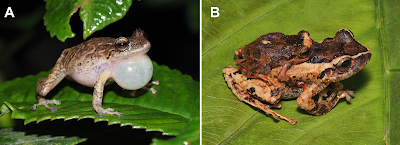 |
| Pristimantis lojanus Székely, Székely, Ordóñez-Delgado, Armijos-Ojeda & Vörös, 2021 |
Abstract
We describe a new species of rain frog of the genus Pristimantis from the city of Loja, Southern Ecuador, based on an integrative taxonomy approach, combining molecular, morphological and bioacoustics data. Pristimantis lojanus sp. nov. is a medium sized species of the phylogenetically strongly supported P. phoxocephalus group, and its sister species is P. torresi. The new species can be easily distinguished from its closest congeners and morphologically similar species (that also have acuminate snout with a fleshy keel) by its characteristic advertisement call and morphological features (dorsum finely tuberculate with scattered larger tubercles, flanks without longitudinal lateral folds, no markings in axilla, groin or on concealed limb surfaces, and bronze iris). Additionally, we describe the advertisement call of its sister species, P. torresi. Finally, we detail the current situation of the amphibian species present in the city of Loja and its surroundings.
Class Amphibia Linnaeus, 1758
Order Anura Fischer von Waldheim, 1813
Superfamily Brachycephaloidea Günther, 1858
Family Strabomantidae Hedges, Duellman, and Heinicke, 2008
Genus Pristimantis Jiménez de la Espada, 1870
 |
| Fig 2. Holotype of Pristimantis lojanus sp. nov. (MUTPL 178, adult female), SVL 35.2 mm, in life. A. Dorsolateral view; B. Ventral view; C. Dorsal view. |
Pristimantis lojanus sp. nov.
Székely, Székely, Ordóñez-Delgado, Armijos-Ojeda, and Vörös
Diagnosis :We assign this species to Pristimantis based on phylogenetic evidence (Fig 1) and on the general morphological similarity to other members of the genus. Pristimantis lojanus is a medium sized species, distinguished by the following combination of traits: (1) skin on dorsum finely tuberculated with scattered larger tubercles (in life the skin tuberculated texture is more evident); skin on venter coarsely areolate to areolate; discoidal fold weak; dorsolateral folds absent; low middorsal fold present; (2) tympanic annulus prominent and tympanic membrane differentiated, its length about 45% of the length of eye; supratympanic fold present, concealing the upper and posterior margin of the tympanum; (3) snout acuminate with a vertical keel in dorsal view, rounded or subacuminate and inclined posteroventrally in profile; canthus rostralis weakly concave in dorsal view, rounded in profile; (4) upper eyelid bearing several small tubercles, similar in size and shape with the ones from the dorsum, about 80% IOD in females and 90% IOD in males; cranial crests absent; (5) dentigerous processes of vomers prominent, oblique, ovoid or triangular, separated medially by distance lower than the width of processes; each processes bearing 4 to 7 teeth; (6) males with a large subgular vocal sac and round vocal slits; nuptial pads present; (7) Finger I shorter than Finger II; discs on fingers broadly expanded, truncate; circumferential grooves present; (8) fingers bearing lateral fringes (trait more evident in life); subarticular tubercles prominent; supernumerary palmar tubercles present; palmar tubercle usually partially divided into a larger (inner) and a smaller (outer) tubercles; thenar tubercle elliptical, larger than the inner palmar tubercle; (9) ulnar tubercles present; (10) heel with several small, rounded tubercles; outer edge of tarsus with a row of small tubercles; inner tarsal fold present; (11) inner metatarsal tubercle broadly ovoid, about 4x or 5x the size of subconical (in profile) outer metatarsal tubercle; supernumerary plantar tubercles present; (12) toes bearing broad lateral fringes (trait more visible in life); webbing basal; Toe V much longer than Toe III; discs on toes broadly expanded, truncate, about same size as those on fingers; circumferential grooves present; (13) in life, dorsum and flanks of various shades of brown or reddish brown, with or without whitish spots or blotches, with or without whitish interorbital bars; venter cream, whitish or yellowish, with or without dark flecks and blotches; no markings in axilla, groin or on concealed limb surfaces; iris bronze with fine black reticulations and a median, horizontal read streak; (14) SVL 28.5–44.3 mm in adult females (34.6 ± 5.39 SD, n = 10) and 26.2–30.4 mm in adult males (28.1 ± 1.43 SD, n = 6).
Etymology: The species epithet refers to the type locality, the city of Loja, with the Latin suffix "-anus" meaning "belonging to".
Common English name: Loja Rain Frog
Common Spanish name: Cutín de Loja
Distribution: Pristimantis lojanus is known from the city of Loja and its close vicinity (all the streams that flow into the city, but also parks like Parque Universitario de Educación Ambiental y Recreación “Francisco Vivar Castro” and private protected areas like Reserva Madrigal del Podocarpus), as well as from several other localities (Fig 12). We also have confirmed records (with DNA samples or call recordings) from San Lucas and its vicinities, Bosque Servio Aguirre Villamagua, Cerro Sacama, Abra de Zamora, Cajanuma, Cristal, and San Antonio de Paycapamba. The species was encountered at an altitudinal range between 1937 m (Cristal) and 2782 m (Bosque Servio Aguirre Villamagua) a.s.l., in evergreen lower montane forest and evergreen upper montane forest ecosystems.
Paul Székely, Diana Székely, Leonardo Ordóñez-Delgado, Diego Armijos-Ojeda and Judit Vörös. 2021. Our Unknown Neighbor: A New Species of Rain Frog of the Genus Pristimantis (Amphibia: Anura: Strabomantidae) from the City of Loja, southern Ecuador. PLoS ONE. 16(10): e0258454. DOI: 10.1371/journal.pone.0258454






